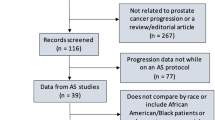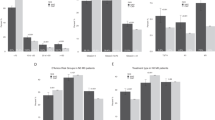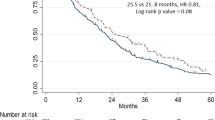Abstract
Background:
In the United States, disease-specific mortality from prostate cancer (PC) is highest among black men. While the introduction of widespread PSA testing has been associated with a downward stage migration, whether this trend continues in the late PSA era and for black men is unknown. The objective of our study was to evaluate current PC stage migration patterns in the United States by race.
Methods:
The Surveillance, Epidemiology and End Results (SEER) registry was queried to obtain all cases of PC reported between 2000 and 2013. Year of diagnosis was categorized into 2000–2003, 2004–2007, 2008–2010 and 2011–2013. Predictors of distant stage PC at diagnosis were determined using logistic regression adjusted for year of diagnosis, age at diagnosis, SEER region and race.
Results:
A total of 791 184 PC cases were identified. The cohort comprised 78.9% (n=594 920) white and 14.1% (n=106 133) black men. The stage at diagnosis was 83.3% localized, 12.0% regional and 4.7% distant. Age-adjusted incidence demonstrated a steady decline for black men in all time groups while white men had a stable incidence of distant disease between 2000 and 2013. In univariate analysis, black men in the 2004–2007 (OR 0.86 (0.81–0.93)) and 2008–2010 cohorts (OR 0.85 (0.79–0.91)) were less likely to be diagnosed with metastatic PC as compared with the 2000–2003 baseline cohort. In multivariate analysis, the 2004–2007 black cohort was less likely to be diagnosed with distant PC (OR 0.90 (0.84–0.97)). This trend was not observed in white men who in multivariate analysis had an increased risk of distant PC in the 2004–2007 (OR 1.08 (1.04–1.11)), 2008–2010 (OR 1.22 (1.18–1.27)) and 2011–2013 (OR 1.65 (1.59–1.71)) groups.
Conclusions:
PC downward stage migration continues in black men but not in white men. Discontinuation of PSA-based screening for PC could disproportionately affect black men.
This is a preview of subscription content, access via your institution
Access options
Subscribe to this journal
Receive 4 print issues and online access
$259.00 per year
only $64.75 per issue
Buy this article
- Purchase on Springer Link
- Instant access to full article PDF
Prices may be subject to local taxes which are calculated during checkout


Similar content being viewed by others
References
Stamey TA, Yang N, Hay AR, McNeal JE, Freiha FS, Redwine E . Prostate-specific antigen as a serum marker for adenocarcinoma of the prostate. N Engl J Med 1987; 317: 909–916.
Catalona WJ, Smith DS, Ratliff TL, Dodds KM, Coplen DE, Yuan JJ et al. Measurement of prostate-specific antigen in serum as a screening test for prostate cancer. N Engl J Med 1991; 324: 1156–1161.
Potosky AL, Miller BA, Albertsen PC, Kramer BS . The role of increasing detection in the rising incidence of prostate cancer. JAMA 1995; 273: 548–552.
Amling CL, Blute ML, Lerner SE, Bergstralh EJ, Bostwick DG, Zincke H . Influence of prostate-specific antigen testing on the spectrum of patients with prostate cancer undergoing radical prostatectomy at a large referral practice. Mayo Clin Proc 1998; 73: 401–406.
Han M, Partin AW, Piantadosi S, Epstein JI, Walsh PC . Era specific biochemical recurrence-free survival following radical prostatectomy for clinically localized prostate cancer. J Urol 2001; 166: 416–419.
Noldus J, Graefen M, Haese A, Henke RP, Hammerer P, Huland H . Stage migration in clinically localized prostate cancer. Eur Urol 2000; 38: 74–78.
Moul JW, Wu H, Sun L, McLeod DG, Amling C, Lance R et al. Epidemiology of radical prostatectomy for localized prostate cancer in the era of prostate-specific antigen: an overview of the Department of Defense Center for Prostate Disease Research national database. Surgery 2002; 132: 213–219.
Scosyrev E, Wu G, Mohile S, Messing EM . Prostate-specific antigen screening for prostate cancer and the risk of overt metastatic disease at presentation: analysis of trends over time. Cancer 2012; 118: 5768–5776.
Etzioni R, Gulati R, Falcon S, Penson DF . Impact of PSA screening on the incidence of advanced stage prostate cancer in the United States: a surveillance modeling approach. Med Decis Making 2008; 28: 323–331.
Aus G, Bergdahl S, Lodding P, Lilja H, Hugosson J . Prostate cancer screening decreases the absolute risk of being diagnosed with advanced prostate cancer—results from a prospective, population-based randomized controlled trial. Eur Urol 2007; 51: 659–664.
Andriole GL, Crawford ED, Grubb RL III, Buys SS, Chia D, Church TR et al. Mortality results from a randomized prostate-cancer screening trial. N Engl J Med 2009; 360: 1310–1319.
Schroder FH, Hugosson J, Roobol MJ, Tammela TL, Ciatto S, Nelen V et al. Screening and prostate-cancer mortality in a randomized European study. N Engl J Med 2009; 360: 1320–1328.
Moyer VA U.S. Preventive Services Task Force.. Screening for prostate cancer: U.S. Preventive Services Task Force recommendation statement. Ann Intern Med 2012; 157: 120–134.
Jani AB, Vaida F, Hanks G, Asbell S, Sartor O, Moul JW et al. Changing face and different countenances of prostate cancer: racial and geographic differences in prostate-specific antigen (PSA), stage, and grade trends in the PSA era. Int J Cancer 2001; 96: 363–371.
Morton RA Jr . Racial differences in adenocarcinoma of the prostate in North American men. Urology 1994; 44: 637–645.
King H, Diamond E, Lilieneld AM . Some epidemiological aspects of cancer of the prostate. J Chronic Dis 1963; 16: 117–153.
Powell IJ, Bock CH, Ruterbusch JJ, Sakr W . Evidence supports a faster growth rate and/or earlier transformation to clinically significant prostate cancer in black than in white American men, and influences racial progression and mortality disparity. J Urol 2010; 183: 1792–1796.
Hoffman RM, Gilliland FD, Eley JW, Harlan LC, Stephenson RA, Stanford JL et al. Racial and ethnic differences in advanced-stage prostate cancer: the Prostate Cancer Outcomes Study. J Natl Cancer Inst 2001; 93: 388–395.
Thompson I, Tangen C, Tolcher A, Crawford E, Eisenberger M, Moinpour C . Association of African-American ethnic background with survival in men with metastatic prostate cancer. J Natl Cancer Inst 2001; 93: 219–225.
Farkas A, Schneider D, Perrotti M, Cummings KB, Ward WS . National trends in the epidemiology of prostate cancer, 1973 to 1994: evidence for the effectiveness of prostate-specific antigen screening. Urology 1998; 52: 444–448; discussion 448-449.
Eifler JB, Feng Z, Lin BM, Partin MT, Humphreys EB, Han M et al. An updated prostate cancer staging nomogram (Partin tables) based on cases from 2006 to 2011. BJU Int 2013; 111: 22–29.
Welch HG, Gorski DH, Albertsen PC . Trends in metastatic breast and prostate cancer—lessons in cancer dynamics. N Engl J Med 2015; 373: 1685–1687.
Powell IJ, Vigneau FD, Bock CH, Ruterbusch J, Heilbrun LK . Reducing prostate cancer racial disparity: evidence for aggressive early prostate cancer PSA testing of African American men. Cancer Epidemiol Biomarkers Prev 2014; 23: 1505–1511.
Weiner AB, Matulewicz RS, Eggener SE, Schaeffer EM . Increasing incidence of metastatic prostate cancer in the United States (2004-2013). Prostate Cancer Prostatic Dis 2016; 19: 395–397.
Drazer MW, Huo D, Eggener SE . National prostate cancer screening rates after the 2012 US Preventive Services Task Force Recommendation discouraging prostate-specific antigen-based screening. J Clin Oncol 2015; 33: 2416–2423.
Demark-Wahnefried W, Catoe KE, Paskett E, Robertson CN, Rimer BK . Characteristics of men reporting for prostate cancer screening. Urology 1993; 42: 269–274; discussion 274–265.
Demark-Wahnefried W, Strigo T, Catoe K, Conaway M, Brunetti M, Rimer BK et al. Knowledge, beliefs, and prior screening behavior among blacks and whites reporting for prostate cancer screening. Urology 1995; 46: 346–351.
Smith RA, Andrews K, Brooks D, DeSantis CE, Fedewa SA, Lortet-Tieulent J et al. Cancer screening in the United States, 2016: a review of current American Cancer Society guidelines and current issues in cancer screening. CA Cancer J Clin 2016; 66: 96–114.
Carter HB, Albertsen PC, Barry MJ, Etzioni R, Freedland SJ, Greene KL et al. Early detection of prostate cancer: AUA Guideline. J Urol 2013; 190: 419–426.
Qaseem A, Barry MJ, Denberg TD, Owens DK, Shekelle P Clinical Guidelines Committee of the American College of, P. Screening for prostate cancer: a guidance statement from the Clinical Guidelines Committee of the American College of Physicians. Ann Intern Med 2013; 158: 761–769.
Wolf AM, Wender RC, Etzioni RB, Thompson IM, D'Amico AV, Volk RJ et al. American Cancer Society guideline for the early detection of prostate cancer: update 2010. CA Cancer J Clin 2010; 60: 70–98.
Izawa JI, Klotz L, Siemens DR, Kassouf W, So A, Jordan J et al. Prostate cancer screening: Canadian guidelines 2011. Can Urol Assoc J 2011; 5: 235–240.
Hayes JH, Barry MJ . Screening for prostate cancer with the prostate-specific antigen test: a review of current evidence. JAMA 2014; 311: 1143–1149.
Cooperberg MR, Carroll PR . Trends in management for patients with localized prostate cancer, 1990-2013. JAMA 2015; 314: 80–82.
Stallings FL, Ford ME, Simpson NK, Fouad M, Jernigan JC, Trauth JM et al. Black participation in the Prostate, Lung, Colorectal and Ovarian (PLCO) Cancer Screening Trial. Control Clin Trials 2000; 21 (Suppl): 379S–389S.
Barocas DA, Grubb R III, Black A, Penson DF, Fowke JH, Andriole G et al. Association between race and follow-up diagnostic care after a positive prostate cancer screening test in the prostate, lung, colorectal, and ovarian cancer screening trial. Cancer 2013; 119: 2223–2229.
Pettaway CA, Troncoso P, Ramirez EI, Johnston DA, Steelhammer L, Babaian RJ . Prostate specific antigen and pathological features of prostate cancer in black and white patients: a comparative study based on radical prostatectomy specimens. J Urol 1998; 160: 437–442.
Sundi D, Kryvenko ON, Carter HB, Ross AE, Epstein JI, Schaeffer EM . Pathological examination of radical prostatectomy specimens in men with very low risk disease at biopsy reveals distinct zonal distribution of cancer in black American men. J Urol 2014; 191: 60–67.
Minamimoto R, Uemura H, Sano F, Terao H, Nagashima Y, Yamanaka S et al. The potential of FDG-PET/CT for detecting prostate cancer in patients with an elevated serum PSA level. Ann Nucl Med 2011; 25: 21–27.
Lecouvet FE, El Mouedden J, Collette L, Coche E, Danse E, Jamar F et al. Can whole-body magnetic resonance imaging with diffusion-weighted imaging replace Tc 99m bone scanning and computed tomography for single-step detection of metastases in patients with high-risk prostate cancer? Eur Urol 2012; 62: 68–75.
Ross LE, Berkowitz Z, Ekwueme DU . Use of the prostate-specific antigen test among U.S. men: findings from the 2005 National Health Interview Survey. Cancer Epidemiol Biomarkers Prev 2008; 17: 636–644.
Bennett CL, Ferreira MR, Davis TC, Kaplan J, Weinberger M, Kuzel T et al. Relation between literacy, race, and stage of presentation among low-income patients with prostate cancer. J Clin Oncol 1998; 16: 3101–3104.
Hebert JR, Hurley TG, Olendzki BC, Teas J, Ma Y, Hampl JS . Nutritional and socioeconomic factors in relation to prostate cancer mortality: a cross-national study. J Natl Cancer Inst 1998; 90: 1637–1647.
Major JM, Norman Oliver M, Doubeni CA, Hollenbeck AR, Graubard BI, Sinha R . Socioeconomic status, healthcare density, and risk of prostate cancer among African American and Caucasian men in a large prospective study. Cancer Causes Control 2012; 23: 1185–1191.
Hoffman RM, Harlan LC, Klabunde CN, Gilliland FD, Stephenson RA, Hunt WC et al. Racial differences in initial treatment for clinically localized prostate cancer. Results from the prostate cancer outcomes study. J Gen Intern Med 2003; 18: 845–853.
Whittemore AS, Wu AH, Kolonel LN, John EM, Gallagher RP, Howe GR et al. Family history and prostate cancer risk in black, white, and Asian men in the United States and Canada. Am J Epidemiol 1995; 141: 732–740.
Freedland SJ, Isaacs WB . Explaining racial differences in prostate cancer in the United States: sociology or biology? Prostate 2005; 62: 243–252.
Kutikov A, Cooperberg MR, Paciorek AT, Uzzo RG, Carroll PR, Boorjian SA . Evaluating prostate cancer mortality and competing risks of death in patients with localized prostate cancer using a comprehensive nomogram. Prostate Cancer Prostatic Dis 2012; 15: 374–379.
Siegel RL, Fedewa SA, Miller KD, Goding-Sauer A, Pinheiro PS, Martinez-Tyson D et al. Cancer statistics for Hispanics/Latinos, 2015. CA Cancer J Clin 2015; 65: 457–480.
Mersha TB, Abebe T . Self-reported race/ethnicity in the age of genomic research: its potential impact on understanding health disparities. Hum Genomics 2015; 9: 1.
Author information
Authors and Affiliations
Corresponding author
Ethics declarations
Competing interests
The authors declare no conflict of interest.
Rights and permissions
About this article
Cite this article
Dobbs, R., Greenwald, D., Wadhwa, H. et al. Is prostate cancer stage migration continuing for black men in the PSA era?. Prostate Cancer Prostatic Dis 20, 210–215 (2017). https://doi.org/10.1038/pcan.2016.68
Received:
Revised:
Accepted:
Published:
Issue Date:
DOI: https://doi.org/10.1038/pcan.2016.68
This article is cited by
-
The Will Rogers phenomenon, breast cancer and race
BMC Cancer (2021)
-
Associations of Prostate-Specific Antigen (PSA) Testing in the US Population: Results from a National Cross-Sectional Survey
Journal of Community Health (2021)
-
Helping Men Find Their Way: Improving Prostate Cancer Clinic Attendance via Patient Navigation
Journal of Community Health (2020)
-
Prostate cancer disparities in Hispanics by country of origin: a nationwide population-based analysis
Prostate Cancer and Prostatic Diseases (2019)
-
Determinants of Clinic Absenteeism: A Novel Method of Examining Distance from Clinic and Transportation
Journal of Community Health (2018)



